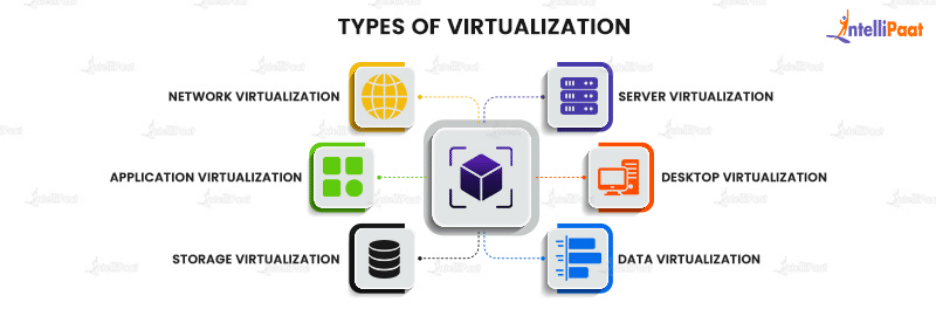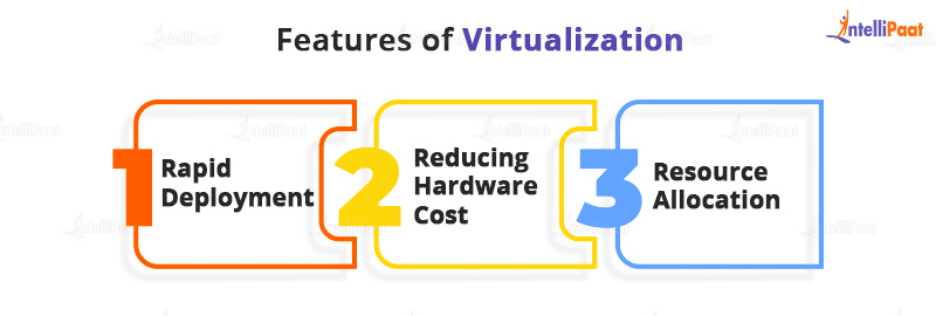What is Virtualization in Cloud Computing?
The idea of creating real items in a virtual environment is known as virtualization. Virtualization is the technique through which things like servers, storage devices, network resources, and operating systems are produced virtually.
Cloud-based technology makes extensive use of virtualization. Normally, with cloud computing, users share the data and programs that are available in the cloud, but with virtualization, users can also share the infrastructure.
Let’s now, take a look at what we’ll be covering in this blog.
Topics Covered are
- Virtualization in Cloud Computing
- Working Of Virtualization
- Features of Virtualization
- Architecture of Virtualization
- Types of Virtualization in Cloud Computing
- Benefits of Virtualization
- Future Scope of Virtualization
- Conclusion
Watch our video on the topic ‘Virtualization of Cloud Computing’ to get a complete understanding of its concepts.
{
“@context”: “https://schema.org”,
“@type”: “VideoObject”,
“name”: “video”,
“description”: “What is Virtualization in Cloud Computing?”,
“thumbnailUrl”: “https://img.youtube.com/vi/_pPlanX5wQY/hqdefault.jpg”,
“uploadDate”: “2023-01-16T08:00:00+08:00”,
“publisher”: {
“@type”: “Organization”,
“name”: “Intellipaat Software Solutions Pvt Ltd”,
“logo”: {
“@type”: “ImageObject”,
“url”: “https://intellipaat.com/blog/wp-content/themes/intellipaat-blog-new/images/logo.png”,
“width”: 124,
“height”: 43
}
},
“contentUrl”: “https://www.youtube.com/watch?v=_pPlanX5wQY”,
“embedUrl”: “https://www.youtube.com/embed/_pPlanX5wQY”
}
Virtualization in Cloud Computing
Services that are made out of already physically existing resources is what we call virtualization. These services such as memory, storage, and operating system are useful in a digital environment.
It allows users to use the existing machines to their fullest capacity, thereby improving business agility where the capabilities of services are distributed.
The host machine is the device on which the virtual machine will be created, and the guest machine is the virtual machine itself.
The virtual machine provides an environment that is logically separated from the existing hardware.
It enables businesses to share a single physical source with numerous users.
Let’s now understand how virtualization works.
Working of Virtualization
Virtualization allows for the separation of an application, a guest operating system, or data storage from the underlying software or hardware.
Virtual machines, created by virtualization, provide their customers additional isolation, flexibility, and control once the majority of systems and applications are fully utilized.
While creating numerous virtual machines on a single physical system, a thin software layer known as a hypervisor mimics the motions and capabilities of the hardware resources for the abstracted hardware or software.
Virtualization offers many benefits which occur because of its features, let’s take a read at the features.
Know all about Cloud Computing by going through Cloud Computing Tutorial.
Features of Virtualization

The key characteristics of virtualization that makes it stand taller in the dynamic market are discussed below. Doing the mentioned tasks without virtualization could lead the organization to spend more on time, costs, or resources. Hence, let’s find out the importance of virtualization.
Rapid Deployment
You can basically deploy virtual resources such as storage, networks, etc very quickly so that it does not take unrequired time.
Reducing Hardware Cost
As more emphasis is placed on using virtual resources, less hardware is used, which lowers the cost associated with it.
Resource Allocation
There are two methods for allocating resources in a virtual environment: dynamic and static.
- Static allocation refers to the virtual environment using a fixed amount of memory that has been assigned to it.
- In dynamic allocation, a virtual environment can expend its memory allocation as and when necessary.
These three mentioned R’s tell a lot about virtualization. Now let’s start with its architecture.
Architecture of Virtualization
The conceptual model of the interconnection between different layers involved in delivering a virtual version of OS or a server rather than a physical version.
The main component in the virtualization architecture is the hypervisor. Multiple virtual machines that share the system’s physical computing resources (including processor time, memory space, network, and other resources) can run simultaneously on the host computer as guests. Thanks to the hypervisor’s ability to isolate operating systems and applications from the underlying computer hardware.
One type of architecture is where the bottom layer is of a physical host hardware platform carried with an emulator, that is the hypervisor (an interface between the physical environment and virtual environment).
Another layer is virtual machines that have a container in them. Each virtual machine has a guest OS that is being hosted by the system and there are different apps running on these various Operating Systems as well. This type of architecture is generally used for server virtualization or desktop virtualization.
The other type of architecture occurs when a host OS is present in addition to the host hardware, followed by a layer of a hypervisor. In this case, you are simulating both the guest OS and the hardware.
These are the two types of architecture in which virtualization occurs. Let’s further take a look at the types of virtualization.
Prepare for your interview by preparing for the Cloud Computing Interview Questions.
Types of Virtualization in Cloud Computing

Virtualization is classified into six types. We’ll examine each one separately.
Network Virtualization
When network resources are abstracted from hardware and put into software, this is referred to as network virtualization. It allows the physical layer to split into different independent virtual networks.
Application Virtualization
It is a process of virtualizing the applications that may or may not be on the guest OS which has been hosted. It isolates an application from the operating system on which it is running. It offers access to an application without requiring the target device to have it installed.
Storage Virtualization
It can be known as the process wherein you combine the physical storage from different network storage devices. This makes it look like a single storage device.
Server Virtualization
It is the process of installing the virtual machine manager (VMM) or virtual machine software directly on the server system. This type of virtualization involves the masking of server resources. Here, the identity number and processors of the physical server are changed to create many virtual servers. Therefore, each system can independently run its own operating system.
Desktop Virtualization
The benefits of desktop virtualization include user portability, user mobility, and simple application installation, updates, and patches. It is the ability to store the OS on a server, allowing the users to access their desktop virtually from any location and even from a different machine.
Data Virtualization
Data collection from numerous sources and management or manipulation done in one location fall under this virtualization.
It can be used to carry out a wide range of tasks, including data integration, business integration, service-oriented architecture, and data services.
Given these wide varieties to use, virtualization is indeed a technology that is making humans put less effort into their digital work field.
Benefits of Virtualization
The key benefits of virtualization in cloud computing are:
- Protection from Failure and Disaster: It prevents your IT system from failing from bugs and viruses. By any chance, if there is even a benefit of the doubt that one part of the system will crash, it will not put any consequence on the complete system.
- Security: In the cloud, virtualization significantly improves security. It’s far more difficult for viruses and malware to spread because virtual machines and virtual infrastructure remain isolated from other components of your systems.
- Ease of Data Transfer: Without having to trawl through actual hard drives or data centers, you can move data quickly between virtualized devices and servers. You can move complete computers using virtualized desktops and storage without transferring any real infrastructure. You’ll consequently save time, effort, and money.
- Better Access Control: System and network administrators are given a higher level of access control, separating their tasks and enhancing the effectiveness of the system.
- Cost-Effectiveness: There is no need to buy physical hardware or software if one is using virtualization, therefore reducing the costs and optimizing the whole expenditures.
We have seen that virtualization in cloud computing helps in enhancing the resilience in disaster management recovery, increasing efficiency and productivity, and allowing faster provisioning of resources. Now let’s take a walk in the future and find out where virtualization in cloud computing stands.
Looking for a professional certificate in Cloud Computing? Have a glance at our Advanced Certification in Cloud Computing & DevOps offered by the industry expert.
Future Scope of Virtualization
Virtualization, when moved to the cloud, led businesses to move their services to the cloud by a huge amount. A wonderful way to provision, scale, and modify IT infrastructure as needs change is through virtualization.
This innovation is moving beyond servers. In the upcoming future, we will see that application and network virtualization will be doubled from what it is today.
The network’s speed, which governs how quickly data is acquired and processed, would be the only constraint. Everything else about using cloud computing will work out if the network is quick. Yet, virtualization will emerge as the future of the digital world.
Conclusion
The advantages of virtualization in cloud computing can truly advance one’s business. You may spend more time creating cloud infrastructure and less time resolving associated problems owing to virtualization’s revolutionary efficiency, unparalleled data protection, enhanced IT operations, and other significant benefits.
If you want to take advantage of virtualization in a cloud computing environment, you must be aware of the specifics of how to successfully virtualize a traditional computer network.
Hoping that this blog has assisted you in learning that information!
Still in hustle and bustle? Visit us on our Community Page!
The post What is Virtualization in Cloud Computing? appeared first on Intellipaat Blog.
Blog: Intellipaat - Blog
Leave a Comment
You must be logged in to post a comment.









